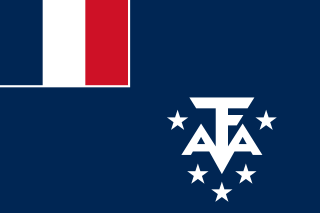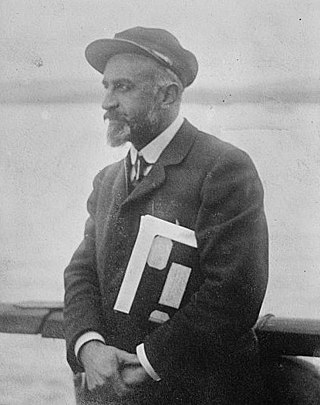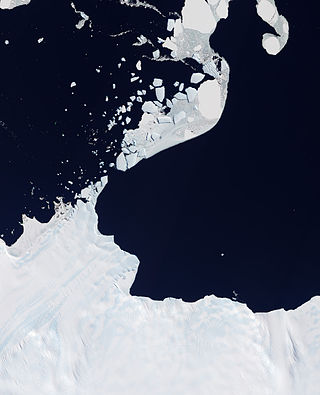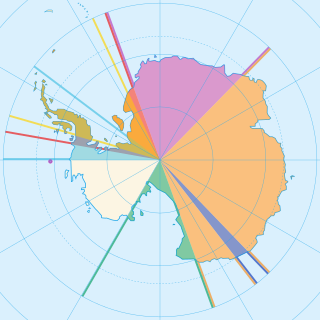This article needs additional citations for verification .(June 2019) |

The French Antarctic Expedition is any of several French expeditions in Antarctica.
This article needs additional citations for verification .(June 2019) |

The French Antarctic Expedition is any of several French expeditions in Antarctica.
In 1837, during an 1837–1840 expedition across the deep southern hemisphere, Captain Jules Dumont d'Urville sailed his ship Astrolabe along a coastal area of Antarctica which he later named Adélie Land, in honor of his wife. During the Antarctic part of this expedition, Dumont d'Urville team performed the first experiments to determine the approximate position of the South magnetic pole, and landed on Débarquement Rock in the Géologie Archipelago, ( 66°36′19″S140°4′0″E / 66.60528°S 140.06667°E ) just 4 km from the mainland, where he took mineral and animal samples. On his return to France in 1840 he was made rear admiral.
Jean-Baptiste Charcot was appointed leader of a 1904–1907 French Antarctic Expedition, aboard the ship Français, exploring the west coast of Graham Land portion of the Antarctic Peninsula. The expedition reached Adelaide Island in 1905 and took pictures of the Palmer Archipelago and Loubet Coast.
They roughly surveyed, the SW coast of Anvers Island in 1904. They gave the name "Presqu'ile de Biscoe" to a small peninsula on the SE side of Biscoe Bay, adding to the honours for John Biscoe – who may have landed in the vicinity in 1832. While the name "Presqu'ile de Biscoe" has not endured, the resurvey by the Falkland Islands Dependencies Survey in 1955 named Biscoe Point for the rocky point found in the approximate location of Charcot's Presqu'ile.
Loubet Land was explored in January 1905 and named after Émile Loubet, then President of France.
Rabot Island was first charted by the expedition and named after Charles Rabot.
They mapped Watkins Island but did not name it. They also charted Arthur Harbour.
Mount Francais ( 64°38′S63°27′W / 64.633°S 63.450°W ) in the Trojan Range was named after the expedition ship Français.
Lavoisier Island was named 'Ile Nansen' after Fridtjof Nansen, Norwegian Arctic explorer. The name was changed in 1960 to avoid confusion with nearby Nansen Island, so named in 1898 by a Belgian expedition.
Bonaparte Point ( 64°47′S64°05′W / 64.783°S 64.083°W ) was charted and named for Prince Roland Bonaparte, then President of the Paris Geographical Society.
Logistics support for this expedition was provided by the Argentine Navy (Armada de la República Argentina), employing the legendary corvette ARA Uruguay.
Within a year of returning from the Second Expedition, Charcot commanded a new expedition from 1908 to 1911. Sailing on the ship Pourquoi-Pas? IV (Why Not? IV), the expedition explored the Bellingshausen Sea, the Amundsen Sea, and discovered, charted and named several features.
Loubet Land was named for Émile Loubet, the President of France during Charcot's earlier expedition.
Charcot Island was named for the Captain himself.
The expedition moored aboard ship in a cove on the southeast side of Petermann Island, which they named Port Circumcision because it was spotted 1 January 1909, the traditional day for the Feast of the Circumcision.
Renaud Island was first charted and named. Fallieres Coast was first explored in January 1909, and Charcot named for Clément Armand Fallières, then President of France.
Mikkelsen Bay was first seen from a distance in 1909, but it was not recognised as a bay. The Mikkelsen Islands were named after Otto Mikkelsen, a Norwegian diver who inspected the damaged hull of the Pourquoi-Pas at Deception Island.
Marguerite Bay was discovered in 1909 and Charcot named the bay after his wife. Jenny Island, in Marguerite Bay, was discovered and named by Charcot for the wife of Sub-Lieutenant Maurice Bongrain, second officer of the expedition.
The name "Pavie" was given in 1909 to an island, or possible cape, shown on the expedition's maps at 68°27′S66°40′W / 68.450°S 66.667°W . Viewed from a position some 15 to 17 miles southeast of Jenny Island, expedition surveyor Maurice Bongrain made sketches of this feature which were labeled both "Île Pavie" and "Cap Pavie". The area later became known as Pavie Ridge.
Adelaide Island was first surveyed by the expedition. They also discovered Millerand Island, which was likely named for Alexandre Millerand, French statesman. Douglas Range was seen from a distance.
Rothschild Island was named after Baron Edouard Alphonse de Rothschild (1868–1949), head of the French branch of the Rothschild family and president of the Rothschild Brothers bank.
The northern portion of Wilkins Sound was first seen and roughly mapped in 1910 by the expedition.
This aborted expedition was led by André-Frank Liotard in 1948–1949. With a total of 62 members, 30 dogs, and 200 tons of equipment aboard Commandant Charcot, it was planned to leave a party of eleven in Adélie Land, where a base was to be constructed. [1] But, with heavy ice pack in February 1949, the ship could never reach the Antarctic coast (southernmost point: latitude 66°11', an estimated 45 miles from the coastline). [2] On their return trip from Antarctica, a party was briefly landed on 3 March 1949 on Sabrina Island, one of the Balleny Islands. [3] The expedition also visited the newly-established Australian base of Macquarie Island, where they made a depot of 7,000 L fuel. [4] [5]
André-Frank Liotard returned to Adélie Land in 1949–1951, again aboard Commandant Charcot. Eleven of the expedition party and 28 dogs were put ashore, and Port Martin Station was established some 60 km to the west of Cape Denison where Douglas Mawson had wintered 40 years before. [6] The party spent a full year doing weather and astronomical research. [7] The expedition charted and named Français Glacier Tongue, Ionosphere Bay and Parasite Bay, among others.
In 1950–1952, Michel Barré led a party of seventeen that wintered at Port Martin. [8]
Two parties were planned to winter in Adélie Land in 1952: one in Port Martin under the leadership of René Garcia; the other in a hut to be erected in the Géologie Archipelago, some 65 km to the west of Port Martin, where an Emperor penguin rookery had been discovered by the 1949–1951 expedition. A fire destroyed Port Martin on 23 January 1952 on the eve the ship Tottan left, and the expedition main party had to re-embark. A small group of seven men decided however to be put ashore at Pointe Géologie, where they wintered under the leadership of Mario Marret. [9] They were relieved in early 1953.
This marks the end of French winterings in Adélie Land before the permanent Dumont d'Urville Station was established in 1956 on Petrel Island, replacing the old base built there in 1952.
The French Polar Expeditions, which have carried out logistics in Adélie Land as of 1948, have adopted a numbering that leaves out Jean-Baptiste Charcot's two voyages of exploration because they do not concern Adélie Land. Thus, they refer to the 1837–1840 expedition as "TA 1" ("TA" is for: "Terre Adélie", Adélie Land in French), while the 1951–1953 expedition is "TA 5". The next expedition in 1956 is "TA 6".

Jules Sébastien César Dumont d'Urville was a French explorer and naval officer who explored the south and western Pacific, Australia, New Zealand, and Antarctica. As a botanist and cartographer, he gave his name to several seaweeds, plants and shrubs, and places such as d'Urville Island in New Zealand.

Adélie Land or Adélie Coast is a claimed territory of France located on the continent of Antarctica. It stretches from a portion of the Southern Ocean coastline all the way inland to the South Pole. France has administered it as one of five districts of the French Southern and Antarctic Lands since 1955 and applied the Antarctic Treaty System rules since 1961. Article 4 of the Antarctic Treaty deals with territorial claims, and although it does not renounce or diminish any preexisting claims to sovereignty, it also does not prejudice the position of contracting parties in their recognition or non-recognition of territorial sovereignty. France has had a permanent station in Adélie Land since 9 April 1950.

The Dumont d'Urville Station is a French scientific station in Antarctica on Île des Pétrels, archipelago of Pointe-Géologie in Adélie Land. It is named after explorer Jules Dumont d'Urville, whose expedition landed on Débarquement Rock in the Dumoulin Islands at the northeast end of the archipelago on January 21, 1840. It is operated by the "French Polar Institute Paul-Émile Victor", a joint operation of French public and para-public agencies. It is the administrative centre of Adélie Land.

Booth Island is a Y-shaped island, 5 nautical miles long and rising to 980 metres (3,220 ft) in the northeast part of the Wilhelm Archipelago, Antarctica.

Sabrina Island is the largest of three small islets lying 1.5 km (0.93 mi) south of Buckle Island in the Balleny Islands of Antarctica and are part of New Zealand's Ross Dependency.

Jean-Baptiste-Étienne-Auguste Charcot, born in Neuilly-sur-Seine, was a French scientist, medical doctor and polar scientist. His father was the neurologist Jean-Martin Charcot (1825–1893).
Biscoe Point is a rocky point forming the south-eastern side of Biscoe Bay, immediately north of Access Point on the south side of Anvers Island, in the Palmer Archipelago of Antarctica.
Lavoisier Island is an island 29 km (18 mi) long and 8 km (5 mi) wide, lying between Rabot and Watkins Islands in the Biscoe Islands, Antarctica. It is separated from Renaud Island and Rabot Island to the northeast by Pendleton Strait, from Watkins Island to the southwest by Lewis Sound, and from Krogh Island to the west-southwest by Vladigerov Passage.
Mikkelsen Bay is a bay, 15 nautical miles wide at its mouth and indenting 10 nautical miles, entered between Bertrand Ice Piedmont and Cape Berteaux along the west coast of Graham Land, Antarctica.
Hanusse Bay is a broad, V-shaped bay, off the west coast of Graham Land, Antarctica. The bay is 37 kilometres (20 nmi) long and trends generally north–south. It is bordered by Cape Mascart on Anvers Island, and Shmidt Point on Arrowsmith Peninsula, Loubet Coast. At its north entrance, Isacke Passage separates it from Liard Island. It is bounded to the south by a line from Landauer Point, the north point of Hansen Island and Bagnold Point on Arrowsmith Peninsula.

Astrolabe Glacier is a glacier 10 kilometres (10 km) wide and 19 kilometres (10 nmi) long, flowing north-northeast from the continental ice and terminating at the coast in a prominent tongue at the east side of Géologie Archipelago. It was first sighted in 1840 by the French expedition under Captain Jules Dumont d'Urville, although no glaciers were noted on d'Urville's chart of this coast but a formidable icy dike with perpendicular flanks of 37.7 m high according to the joined plate, corresponding to the glacier tongue. The glacier was photographed from the air by U.S. Navy Operation Highjump in January 1947. It was charted by the French Antarctic Expedition, 1949–51, and named after d'Urville's flagship, the Astrolabe.

Débarquement Rock is an ice-free rock 200 metres (220 yd) long and 18.7 m high, marking the northern end of the Dumoulin Islands and the north-eastern end of the Géologie Archipelago.

Avery Plateau is an ice-covered plateau, about 40 miles (64 km) long and rising to about 2,000 metres (6,600 ft), midway between Loubet Coast and Foyn Coast in Graham Land, Antarctica. It borders Hemimont Plateau on the south and Bruce Plateau on the north. The first sighting of this plateau is not certain, but it was presumably seen in January and February 1909 by members of the French Antarctic Expedition under Jean-Baptiste Charcot from various positions in the Matha Strait. It was surveyed in 1946–47 by the Falkland Islands Dependencies Survey, and named by the UK Antarctic Place-Names Committee (1955) after Captain George Avery, master of the cutter Lively, who, with Captain John Biscoe in the brig Tula, approached this part of the Antarctic Peninsula in February 1832.

Seven sovereign states – Argentina, Australia, Chile, France, New Zealand, Norway, and the United Kingdom – have made eight territorial claims in Antarctica. These countries have tended to place their Antarctic scientific observation and study facilities within their respective claimed territories; however, a number of such facilities are located outside of the area claimed by their respective countries of operation, and countries without claims such as China, India, Italy, Japan, Pakistan, Russia, South Africa (SANAE), Poland, and the United States have constructed research facilities within the areas claimed by other countries. There are overlaps among the territories claimed by Argentina, Chile, and the United Kingdom.
Mount Barre is a mountain with an ice-covered, pyramidal peak, 2,195 m, standing 2 nautical miles (3.7 km) northeast of Mount Gaudry in the south part of Adelaide Island. Discovered and surveyed in 1909 by the French Antarctic Expedition under Charcot. Resurveyed in 1948 by the Falkland Islands Dependencies Survey (FIDS) and named by the United Kingdom Antarctic Place-Names Committee (UK-APC) for Michel Barre, leader of the French Antarctic Expedition to the Adelie Coast, 1951–52.

Cape Jules is a rocky cape with a small cove along its northern end, 3 nautical miles (6 km) west of Zelee Glacier Tongue, Antarctica. It was discovered and named by the French expedition under Dumont d'Urville, 1837–40. Jules is the given name of the discoverer, Captain Jules Dumont d'Urville, as well as his son. The area was charted by the Australasian Antarctic Expedition in 1912–13, and again by the British Australian and New Zealand Antarctic Research Expedition in 1931, both under Mawson. The French Antarctic Expedition under Michel Barre established astronomical control at this locality in 1951.

The Géologie Archipelago, also known as the Pointe Géologie Archipelago, Geology Archipelago or Cape Geology Archipelago, is a small archipelago of rocky islands and rocks close to the north of Cape Géodésie and Astrolabe Glacier Tongue, extending from Helene Island on the west to the Dumoulin Islands on the east, in Adélie Land, Antarctica.
Matha Strait is a strait lying between Adelaide Island and the south end of the Biscoe Islands. The strait takes its name from "Matha Bay", the name originally applied by Jean-Baptiste Charcot, leader of the French Antarctic Expedition, 1908–10, to the water feature as he conceived it. The British Graham Land Expedition under John Rymill, 1934–37, recognizing that it is really a strait rather than a bay, changed the name to Matha Strait. The name is for Lieutenant André Matha, second-in-command of the French Antarctic Expedition, 1903–05, also under Charcot.
Luc-Marie Bayle was a French naval officer, painter, and artist.